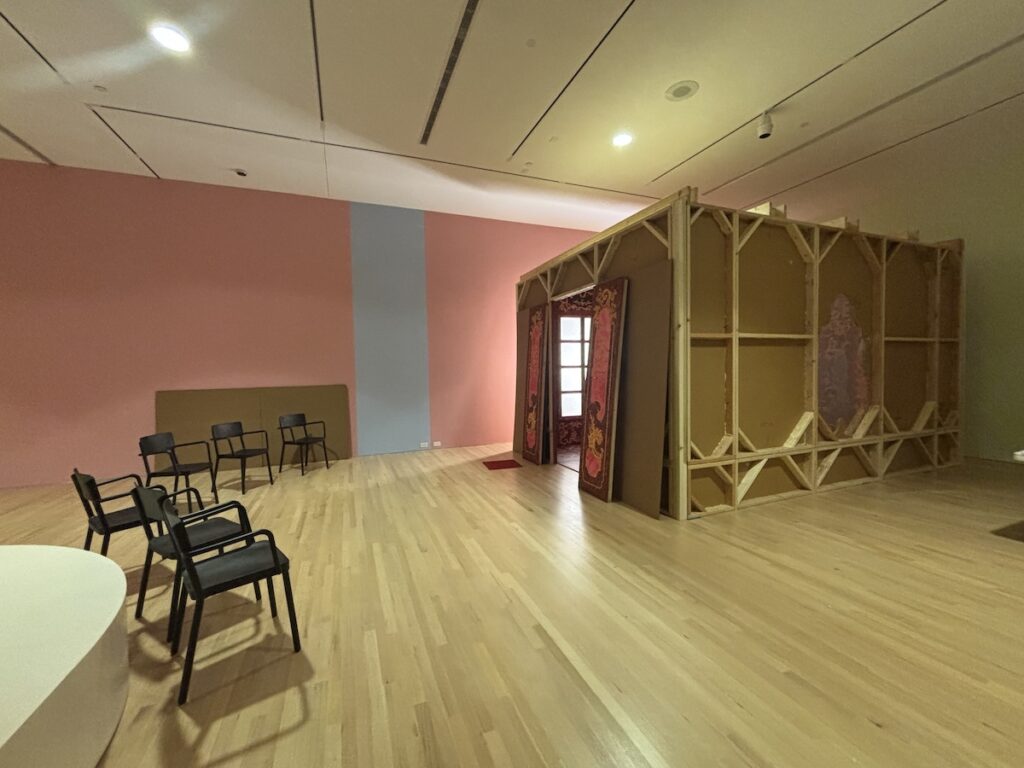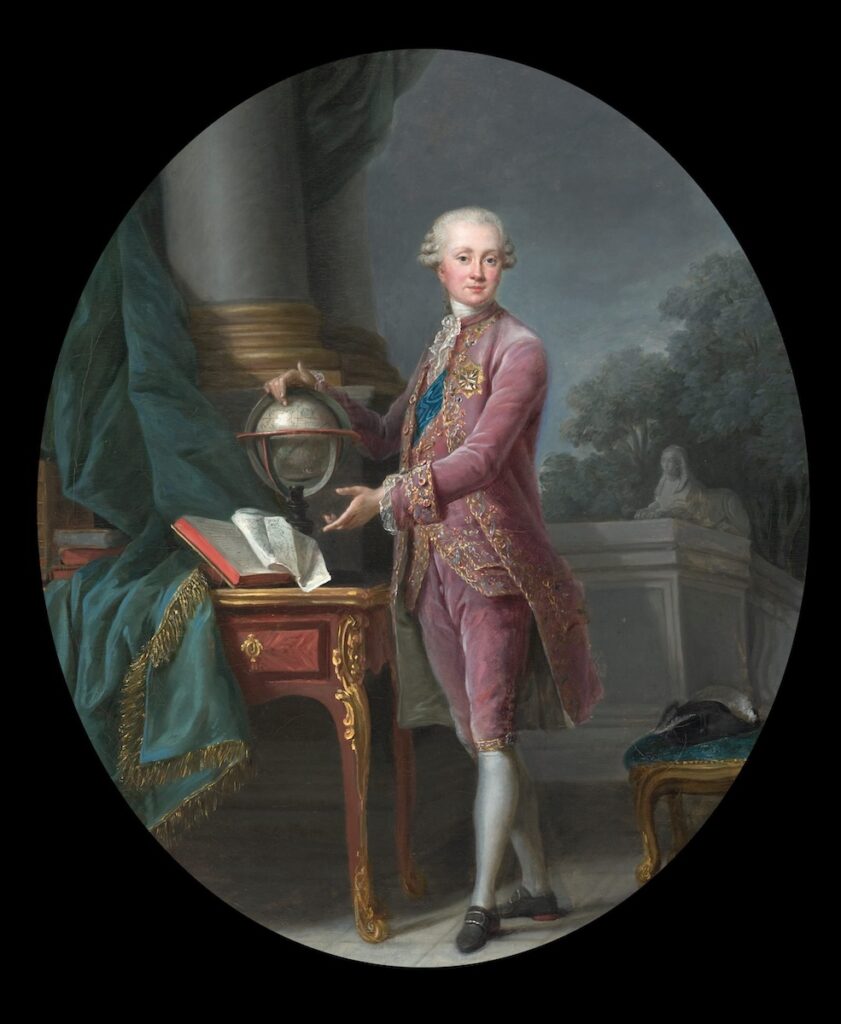Rococo period rooms have always been fantasies assembled from pieces of wall paneling, furnishings, and objets d’art that often have no historical link to each other but are designed to simulate and invoke some kind of eighteenth-century reality. Robert Horvath’s Room for the Lost Paradise (2024-25) plays with this idea of simulation, which was a hallmark of rococo aesthetics, but he also exposes the myth by highlighting the constructed nature of the space. Following the rococo rejection of truth to materials, the entire room is actually one giant watercolor that variously mimics wood parquet, gilded boiseries, porcelain vases, and pink silk damask. For the most part, this trompe l’oeil illusion stays intact; it is only when you get up close that you start to see the curling edges of cut paper and realize that all is not as it seems. The figures lifted from Watteau’s Cythera, upon closer inspection, look a bit green, and they also appear to be at risk of drowning or sinking like their capsized boat, which has succumbed to rising water levels. A clock with porcelain add-ons that resembles an eighteenth-century assemblage turns out to be mounted not with a Meissen figural group but with a recent photograph of two big game hunters holding up a leopard they have killed. The illusion is shattered above all by the room’s raw exterior, which looks like a shipping container that has transported this otherworldly space from the distant past and dropped it into our own doomed present (Fig. 1).

From their emergence in the eighteenth century, rococo art and interiors were meant to encourage dreamlike reverie and engage a viewer’s personal history and memories. This is one reason why these undeniably elitist spaces continue to inspire broad, open-ended meditations on identity, desire, and belonging today. More recently, in my own research I have been thinking about the identities and desires of the eighteenth-century patrons who commissioned these rooms, as well as the mostly invisible servants, craftspeople, and other actors who inhabited them. I’ve been wondering how museums could go deeper and devise new ways of telling these life stories (perhaps with the help of contemporary artists and performers) as a way to make period rooms more engaging for contemporary audiences. Horvath’s Room for the Lost Paradise prompted me to wonder about the historical patron who could possibly have commissioned and lived in such a space, and that, in turn, led me to recall a painting I had seen the only other time I visited the Indianapolis Museum of Art: Elisabeth Vigée Le Brun’s Portrait of the Prince of Nassau-Siegen (Fig. 2). I thought it might be interesting to conduct a brief thought experiment and put these two artworks (the painting and the room) in dialogue with each other and see what the connection might generate.

Karl Heinrich von Nassau-Siegen (1743-1808), known as the Prince of Nassau, was the kind of guy for whom the rococo was invented. He was born in France but also lived in Spain, Poland, and Russia, and he styled himself a prince, even though his father was deemed a bastard and his noble family did not recognize his claim. An inveterate gambler who racked up debts and had to escape his creditors, he managed to join the French explorer Louis Antoine de Bougainville’s famous 1763 scientific mission to circumnavigate the globe (a historical event that didn’t, but could have, served as inspiration for Horvath’s room). Karl Heinrich sailed with the celebrated botanists Philibert Commerson and Jeanne Baret, who disguised herself as a man to sneak on the trip and was allegedly outed by Tahitian Islanders she met on her journey. (Some historians suggest that Aoutourou, the Tahitian man who traveled with Bougainville’s mission back to Paris, thought Baret was a gender-fluid māhū). Back in Europe, Karl Heinrich wrote a memoire of the voyage touting his diplomatic “prowess,” notably with Tahitian women, and he hailed Tahiti as an Edenic paradise untroubled by European sexual mores. He also commissioned Vigée Le Brun to paint his portrait, in which he arrogantly grips a globe while pointing to a map of “Otaiti” (Tahiti) propped up on a gilded rococo desk possibly veneered with tropical hardwoods. Standing tall and proud in his noble red heels and resplendent purple suit, he embodies the period mentality among elite white Europeans that the world and its riches were theirs for the taking.
Rococo rooms embodied this mentality too. We might imagine Room for the Lost Paradise as an interior designed for the self-professed “Prince” to look fondly back on his travels and the paradisical pleasures he extracted from them. The watercolor parquet on its walls and floors is meant to imitate rosewood, a rare tropical hardwood found mainly in South America (the first stop on the Bougainville tour), and the botanical leaves and flora that comprise the gilded paneling all come from exotic, now-endangered species like the many samples Baret collected. Some of the décor, like the porcelain and coral, also reference maritime trade and extraction along with other destinations on the Bougainville voyage, and the photograph of big game hunters eerily echoes a ridiculous painting of the prince shooting a tiger that he commissioned from Francesco Casanova (brother of the more famous libertine). It’s not hard to picture Karl Heinrich manspreading on a velvet chair in this rococo interior and boasting about his travels, probably from his retirement home in present-day Ukraine (he had wanted to be a Russian oligarch but didn’t succeed; Wikipedia describes him as Catherine the Great’s “least successful naval commander”). “Lost Paradise” here takes on multiple meanings.
Contemporary art can challenge viewers to reimagine and ask new questions about the past, even about a historical era they have studied for many years. Horvath claims he is not a rococo specialist, but his room taps deeply into some of the more meaningful elements of the style—in terms of illusionism, materials, and connection to colonial pursuits—and especially the rococo’s incessant capacity for storytelling and reinvention, a quality its admirers have always loved.
Meredith Martin is Professor of Art History at New York University and a founding editor of Journal18
Cite this note as: Meredith Martin, “Paradise Lost” Journal18 (July 2025), https://www.journal18.org/7918.
License: CC BY-NC
Journal18 is published under a Creative Commons CC BY-NC International 4.0 license. Use of any content published in Journal18 must be for non-commercial purposes and appropriate credit must be given to the author of the content. Details for appropriate citation appear above.
